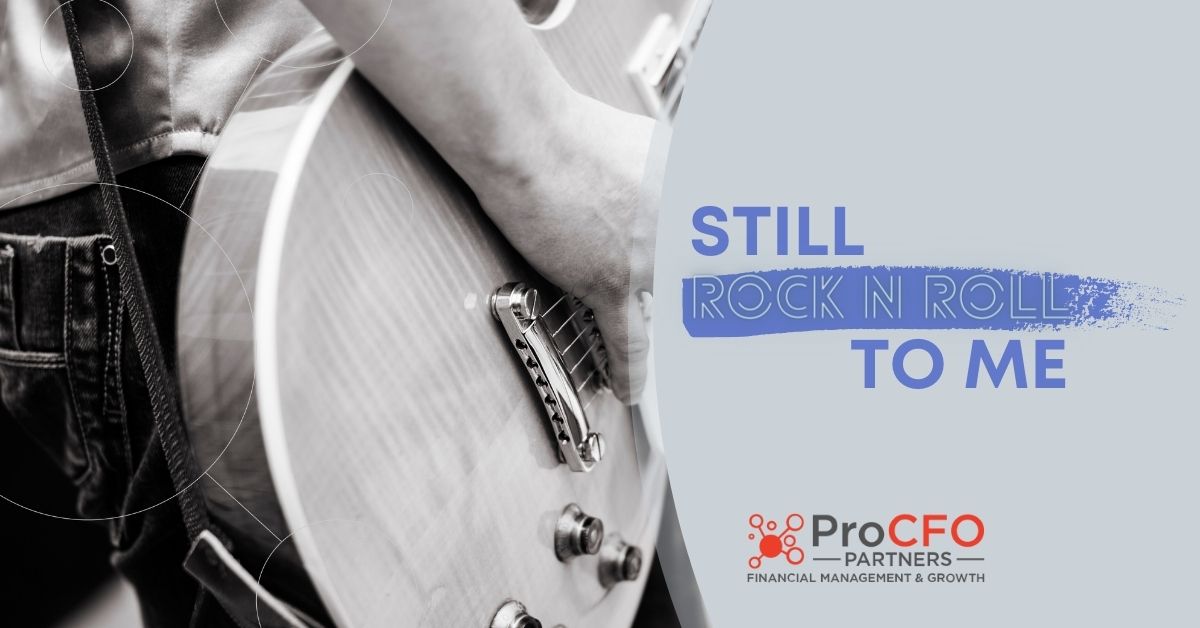Music Industry Financials: Still Rock n Roll To Me
Mar 4, 2022
The music industry involves a unique and sometimes dizzying framework for financial functions. Understanding who gets paid what, and when, is a more complex exercise than for a typical business. It might surprise you to know some of the financial nuances involved for that song you love to listen to. In this article we’ll explore some of these points and ultimately discuss why all this is relevant to you in your business, whatever business you’re in.
One Song = Two Products
One of the first things to understand is what, from the music business’s point of view, a song consists of. There are two pieces of intellectual property – copyrights – to every song.
Composition copyright
The composition consists of the song’s lyrics and melody. Many songs you hear, from artists you might really enjoy, weren’t written by that artist. Commonly a composition gets “shopped” among different recording artists and record labels before one of those artists decides to record it. It’s also common for certain songwriters to have a relationship with certain artists. And of course, some recording artists also write their own songs, yet there remains a distinction between the recording and the composition.
The copyright of the composition belongs to the writer, who then authorizes a publisher to manage it. The recording artist’s role isn’t a part of this business relationship (again, even if the recording artist wrote the song, think of them as wearing an entirely different hat where publishing is concerned.)
Sound Recording copyright
This is what you, the listener, ultimately hear. It’s the audio recording of the song. This is also called the “master” copyright.
There are, then, two copyrights involved with every song. When a song is purchased, money from the sale is distributed to both copyrights. Let’s think of them as products, because each can generate revenue in unique ways.
Royalties Rule Them All
A royalty is the payment made to the appropriate copyright (“product”) holder. What each holder gets paid, and why, is dependent on the use case. This includes (but is by no means exhaustive) when a song is:
- Streamed
- Purchased
- Included in a TV show, movie, commercial etc.
- Is played on the radio
- Gets covered by another artist
- Gets sampled in a new work
- Is performed live
Diving into each of these isn’t necessary for this article, but can involve different royalty rates (amount of revenue) based on many kinds of criteria.
It is useful to understand how each product, or copyright, impacts the royalty of its holder. In 1985 Michael Jackson purchased the publishing rights to a number of Beatles hits. (Incidentally, the company he purchased was called ATV. More on this in a bit, but if you’re wondering how on earth the Beatles lost their publishing in the first place, give it a google). He didn’t buy the masters – or the sound recording copyrights – just the copyrights to the compositions – the publishing. This meant Jackson, through ATV, could license those compositions for really any purpose they wanted. Other artists could cover the songs, for instance, or they could be sung by other artists in commercials or jingles. And of course every time Hey Jude was played on the radio or even performed in concert by Paul McCartney (or anybody else) ATV was paid a royalty.
Position this against the master. For a royalty to be delivered to this “product” the actual sound recording has to be used. In 1987 Nike famously used the Beatles song Revolution in a commercial. Even though Yoko Ono (John Lennon’s widow, who held shares to the masters) helped broker the deal, the band’s record label (additional owners of the sound recording) sued Nike for $15 Million.
This is one reason why publishing is so valuable, and why people who contribute to a song’s composition like to “have a piece of the publishing” – they get paid a percentage of the royalty whenever their product creates revenue. Manfred Mann’s Earth Band is famous for their staple Blinded By The Light, which was actually written by Bruce Springsteen. Springsteen makes money every time the song is played on the radio or even in a dingy bar off the highway.
There’s maybe no better modern example of the business behind the music than Taylor Swift, who wrote or co-wrote every song on all of her albums. As the songwriter, she receives a royalty every time one of her songs makes money as part of the composition copyright. The masters – the sound recording copyrights – of her first six albums were owned by her record label, Big Machine Records. In 2019 Big Machine was purchased by a conglomeration of private equity firms, fund managers, and others for $330 Million dollars. This meant the rights to the master recordings, music videos, and other elements of every master Big Machine Records owned went to the new owners. By far the most valuable assets to command such a selling price were Swift’s masters. The ability to license these recordings in perpetuity and for whatever purpose promised high potential returns.
Except Swift wasn’t having it. She claimed she’d been trying to buy the masters to her songs for years and that the selling parties involved were disingenuous in their negotiations. So after the sale of Big Machine, she committed to the unprecedented venture of re-recording every song, note for note, of her first six albums, thus creating new, original masters. Calling these “Taylor’s Version”, Swift has so far re-recorded two of her records, releasing her new versions to become hits once again.
Back to the products involved – Swift already owns or co-owns the compositions to these songs and receives royalties in kind. Now she also owns masters to her new versions of her old songs – receiving additional royalties. Leveraging her enormous fan base and popularity, the original versions are becoming quickly obsolete as her new versions are what’s being streamed and purchased.
Here’s one more illustration on the value of publishing: Remember ATV, the company Michael Jackson bought that included the Beatles catalog? Jackson bought ATV for $47.5 million. In 1995 he made a deal worth $110 million with Sony Music Publishing, selling them a 50% stake in ATV while taking a stake in Sony’s publishing. The new publishing company was called Sony/ATV. In 2016 Sony bought out the remaining 50% from the estate of Michael Jackson for $750 million. If you’re keeping score, that’s nearly $900 million in deals from a property purchased for less than $50 million – nevermind all the revenue the compositions themselves had been generating all those years. Among the Sony/ATV catalog helping to drive that much revenue are Taylor Swift’s compositions.
Recoupment and the Record Industry
Another unique aspect to the music business, more specific to the recording artist and the royalties on the masters, is how record labels invest in those products.
When a recording artist signs a contract with a record label, there are typically a number of conditions involved and the contracts can get long and complex. Often the recording artist will receive an advance from the record label. Here’s a check for $500,000! And the band all goes out and buys new cars.
But that advance isn’t really the band’s money – it’s recoupable. And the advance can be used for everything from hiring producers that help create recordings to renting studio space and hiring audio engineers to paying for a crew to go on tour.
The record company and the recording artist each get a percentage of royalties from the masters. Typically the percentage the record label pays to artists is 10% to 15% of the retail price.
Before the artists can basically see a dime of their share of the earnings, they have to repay the record company for their advance. If their record doesn’t sell well, they can stay on the hook, even accruing more “debt” with the record company, until the company recoups their investments.
This is one reason why massively successful artists are so valuable to a record company. Their revenue can offset less successful artists. It’s also why live performance is so popular for artists. There’s only so much the artist can make from selling a record, and particularly with the business model shifting to pennies-per-play on streaming platforms, it can be hard for an artist to make money. Concerts create a lucrative additional revenue stream that can include expensive VIP packages, merchandise sales and more.
What Does Any Of This Have To Do With You?
We talk a lot at ProCFO Partners about the value of our network of CFOs and their collective expertise and experience. In this article we’ve really barely scratched the surface on the intricacies of finance in the music industry and you can easily see how complex it can be. Thomas McNiff was the CFO for a label in the 2000’s that was home to some of the biggest names on the radio. Today’s he’s among our team at ProCFO Partners. Tom deftly knows his way around the many curves and corners of financials in the music industry, and he puts that skill set to use for companies like yours today. His experience in the record industry also taught him patience and communication skills. Remember, the creators of the label’s most valuable assets weren’t business men and women, they were artists. Tom and the label he was involved in were committed to fairness and transparency with artists, which meant helping them understand the business. Like all of our CFOs, Todd takes the skills learned and applies them to businesses across many industries today.
Among the benefits of the fractional or part-time CFO is this ability to draw from diverse and dynamic experiences. This helps you and your company approach your own financial functions from fresh perspectives, more informed points of view and original ideas.


